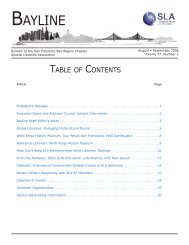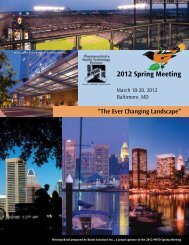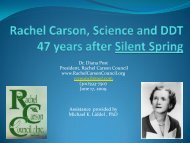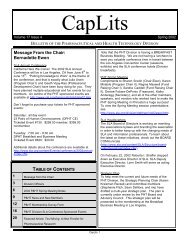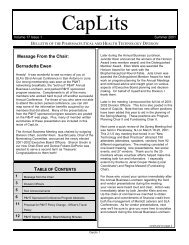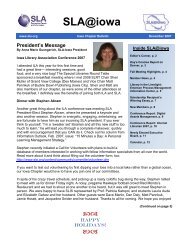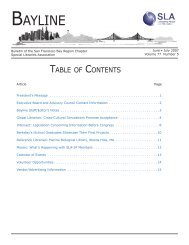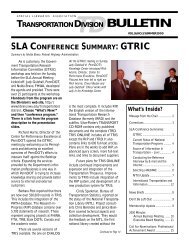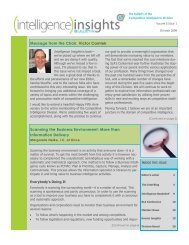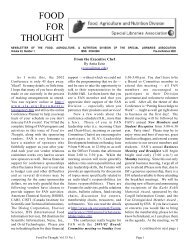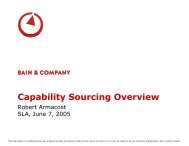Education Libraries - Special Libraries Association
Education Libraries - Special Libraries Association
Education Libraries - Special Libraries Association
Create successful ePaper yourself
Turn your PDF publications into a flip-book with our unique Google optimized e-Paper software.
practical solutions to the challenges of assessing ELLs.<br />
This work was designed to assist educators in<br />
distinguishing between learning disabilities and other<br />
explanations for underachievement. Its main goal is to<br />
provide information that will lead to the most<br />
appropriate education for ELLs while reducing<br />
inappropriate referral and placement to special<br />
education. Divided into manageable chapters, each set of<br />
contributors makes a valiant effort to cover succinctly a<br />
very complex topic.<br />
The first two chapters discuss all the necessary<br />
background information on ELL demographics and the<br />
language acquisition process. Chapter two is especially<br />
well done as it addresses eight misconceptions about<br />
second language acquisition. This discussion is revealing<br />
and thought provoking as it lays bare many<br />
misunderstood ideas. Implications for practice are<br />
outlined that deftly guide readers to think about these<br />
issues in a whole new way.<br />
The remainder of the chapters use the framework of<br />
Response to Intervention (RTI) models to discuss how<br />
second language acquisition differs from learning<br />
disabilities and what things to consider when assessing<br />
the performance of ELLs. Each chapter expertly clarifies<br />
this new practice and describes how the procedures are<br />
similar to and different from previous approaches.<br />
Additional information on how data-driven decision<br />
making should be implemented in this model is also<br />
given.<br />
All the chapters give practical advice for those in the<br />
beginning stages of working with ELLs and new models.<br />
This basic level of information makes this work an<br />
excellent primer for those who have had little or no<br />
experience with an ELL population or the models<br />
described. Additionally all chapters include numerous<br />
guides, checklists, figures, tables and easy reference<br />
guides. The book concludes with an extensive reference<br />
list and a useful index. All chapters contain very<br />
informative Research to Practice sidebars that describe<br />
in detail important research projects and their outcomes.<br />
Overall, this is a resource for beginners, with just<br />
enough information and guidance to help focus thinking<br />
and steer new practitioners on the right path. Educators<br />
at all stages will find this a good guide to help make<br />
informed instructional and eligibility decisions for<br />
English language learners.<br />
Rachel Wadham is the <strong>Education</strong> Librarian at Brigham<br />
Young University. Email: Rachel_Wadham@byu.edu.<br />
A History of the<br />
World Cup: 1930-<br />
2006—Reviewed<br />
by Warren<br />
Jacobs<br />
Lisi, Clemente<br />
Angelo. A History<br />
of the World Cup:<br />
1930-2006.<br />
Lanham, MD:<br />
Scarecrow Press,<br />
2007. ISBN 978-<br />
0-8108-5905-0.<br />
$29.95.<br />
The world’s most popular sport is football, known in<br />
America as soccer. Soccer fans are passionate, engaging<br />
in joyful celebrations of national pride after a victory or<br />
furious riots after a loss. Soccer’s most important<br />
international competition is the World Cup. There have<br />
been many upsets throughout the 76 year history of the<br />
quadrennial tournament, although only seven national<br />
teams have emerged victorious.<br />
Clemente Angelo Lisi is a news reporter and<br />
longstanding soccer aficionado. Lisi set out to create an<br />
encyclopedia of the World Cup for American readers<br />
unfamiliar with the tournament. A History of the World<br />
Cup: 1930-2006 documents the tournament’s<br />
beginnings, providing anecdotes and biographical<br />
sketches of the major participants.<br />
Following the table of contents is a foreword authored<br />
by United States national soccer team member Brian<br />
Quinn. An introductory essay discusses the author’s<br />
background in soccer, and provides context for the<br />
World Cup in comparison with football, baseball,<br />
basketball, and hockey.<br />
The text is divided into eight chapters. Each chapter<br />
presents the major events of the World Cup year,<br />
followed by profiles of renowned national teams like<br />
Brazil and Italy, and descriptions of qualifying round<br />
competition, group play, quarterfinal and semifinal<br />
contests, and championship games. Biographies,<br />
statistical records, and pictures of prominent players like<br />
Pelé, Maradona, and Ronaldo are interspersed<br />
throughout the text. Each chapter concludes with notes<br />
to document sources.<br />
<strong>Education</strong> <strong>Libraries</strong>, Volume 31, No. 2, Winter 2008 57



